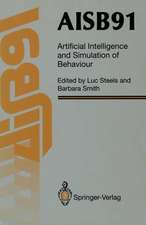Long Term Human-Computer Interaction: An Exploratory Perspective
Autor Richard C. Thomasen Limba Engleză Paperback – 26 aug 1998
Preț: 642.33 lei
Preț vechi: 802.90 lei
-20% Nou
Puncte Express: 963
Preț estimativ în valută:
122.93€ • 127.86$ • 101.48£
122.93€ • 127.86$ • 101.48£
Carte tipărită la comandă
Livrare economică 14-28 aprilie
Preluare comenzi: 021 569.72.76
Specificații
ISBN-13: 9783540762096
ISBN-10: 3540762094
Pagini: 212
Ilustrații: XXII, 187 p. 6 illus.
Dimensiuni: 155 x 235 x 11 mm
Greutate: 0.33 kg
Ediția:Softcover reprint of the original 1st ed. 1998
Editura: SPRINGER LONDON
Colecția Springer
Locul publicării:London, United Kingdom
ISBN-10: 3540762094
Pagini: 212
Ilustrații: XXII, 187 p. 6 illus.
Dimensiuni: 155 x 235 x 11 mm
Greutate: 0.33 kg
Ediția:Softcover reprint of the original 1st ed. 1998
Editura: SPRINGER LONDON
Colecția Springer
Locul publicării:London, United Kingdom
Public țintă
ResearchCuprins
1. Setting the Scene.- 1.1 Evidence for Continuous Change.- 1.2 A Changing Focus in HCl.- 1.3 Framework for Long Term Interaction.- 1.4 The Costs of Longitudinal Studies.- 1.5 The Sydney Study.- 1.6 Outline of the Book.- 2. The Long Haul From Novice to Expert.- 2.1 Skill Acquisition.- 2.2 The Problems of Novices.- 2.3 Experienced Performance.- 2.4 Longitudinal Studies.- 2.5 Conclusion.- 3. Data Collection.- 3.1 Approaches to Longitudinal Data Collection in HCI.- 3.2 The White Rat of HCI.- 3.3 Monitoring at Sydney.- 3.4 Cohorts.- 3.5 Drop Out Rates.- 3.6 Summary.- 4. Learning and Transfer.- 4.1 The First Lab.- 4.2 Task Descriptions.- 4.3 Initial Learning in 1991.- 4.4 Initial Learning in 1992 and 1993.- 4.5 Typing Speeds.- 4.6 Performance Improvements in Editing.- 4.7 Conclusions.- 5. A Fresh Look at Vocabulary.- 5.1 Previous Work.- 5.2 Frequencies in the Sydney Study.- 5.3 The Type Token Ratio.- 5.4 Trends in TTR.- 5.5 Transitions in the TTR.- 5.6 Other Behaviours.- 5.7 Discussion.- 5.8 Conclusions.- 6. Exploration.- 6.1 Previous Field Studies of Exploration.- 6.2 Operational Definition of Exploration.- 6.3 Early Exploration.- 6.4 Continuous Exploration.- 6.5 Serendipity.- 6.6 The Importance of Chance.- 6.7 Conclusions.- 7. Crossovers.- 7.1 A Classification of Temporal Effects.- 7.2 Longitudinal Changes in sam Command Use.- 7.3 File Write Methods.- 7.4 Visualisation Technique.- 7.5 File Write Crossover Results.- 7.6 Discussion.- 7.7 The Zone of Exploration Model.- 7.8 Conclusion.- 8. Conclusions.- 8.1 Methodologies.- 8.2 Process Dynamics.- 8.3 Implications for Design.- 8.4 Training, Education and Job Design.- References.- A. Command Codes and Ranks.- A.1 Command Ranks for the 91–93 Cohort.- A.2 Honours Year Command Ranks.- B. A Model of the Command Distribution.- B.1Introduction.- B.2 Application to Observed Vocabulary.- Author Index.















